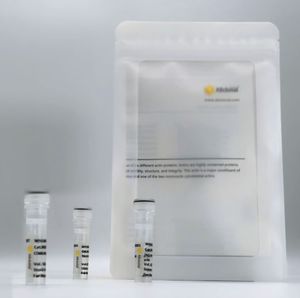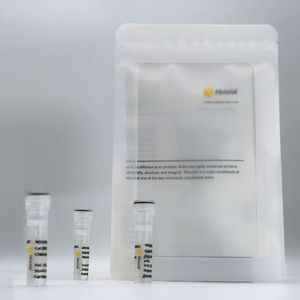
- Laboratory
- Laboratory medicine
- Enzyme reagent
- ABclonal Technology

- Company
- Products
- Catalogs
- News & Trends
- Exhibitions
Enzyme reagent A20022immunohistochemistryfor immunofluorescenceprotein
Add to favorites
Compare this product
Characteristics
- Type
- enzyme
- Applications
- immunohistochemistry, for immunofluorescence
- Tested parameter
- protein
- Micro-organism
- coronavirus
Description
Host species - Rabbit
Purification method - Affinity purification
Isotype - IgG
Background
The spike (S) glycoprotein of coronaviruses contains protrusions that will only bind to certain receptors on the host cell. Known receptors bind S1 are ACE2, angiotensin-converting enzyme 2; DPP4, dipeptidyl peptidase-4; APN, aminopeptidase N; CEACAM, carcinoembryonic antigen-related cell adhesion molecule 1; Sia, sialic acid; O-ac Sia, O-acetylated sialic acid. The spike is essential for both host specificity and viral infectivity. The term 'peplomer' is typically used to refer to a grouping of heterologous proteins on the virus surface that function together. The spike (S) glycoprotein of coronaviruses is known to be essential in the binding of the virus to the host cell at the advent of the infection process. It's been reported that 2019-nCoV can infect the human respiratory epithelial cells through interaction with the human ACE2 receptor. The spike protein is a large type I transmembrane protein containing two subunits, S1 and S2. S1 mainly contains a receptor binding domain (RBD), which is responsible for recognizing the cell surface receptor. S2 contains basic elements needed for the membrane fusion.The S protein plays key parts in the induction of neutralizing-antibody and T-cell responses, as well as protective immunity.
Applications
Recommended dilution -
ELISA 1:1000 - 1:5000
WB 1:2000 - 1:10000
FC 1:50 - 1:200
IF/ICC 1:50 - 1:200
IP 1:50 - 1:200
Storage buffer - Store at 4℃ Avoid freeze / thaw cycles.
Buffer: PBS with 0.05% proclin300, pH7.3.
Application key - Western blotting Flow Cytometry Immunofluorescence Immunoprecipitation
Positive samples - 293T
Catalogs
No catalogs are available for this product.
See all of ABclonal Technology‘s catalogsRelated Searches
- Assay kit
- Solution reagent kit
- Blood assay kit
- Molecular biology reagent kit
- Serum assay kit
- Immunoassay assay kit
- Plasma assay kit
- Research reagent kit
- Protein reagent kit
- Diagnostic reagent kit
- Laboratory reagent kit
- Enzyme reagent kit
- Reagent medium reagent kit
- Immunology reagent
- Cytology reagent kit
- Antibody
- Buffer solution reagent kit
- Dye reagent
- ELISA assay kit
- PCR reagent kit
*Prices are pre-tax. They exclude delivery charges and customs duties and do not include additional charges for installation or activation options. Prices are indicative only and may vary by country, with changes to the cost of raw materials and exchange rates.




